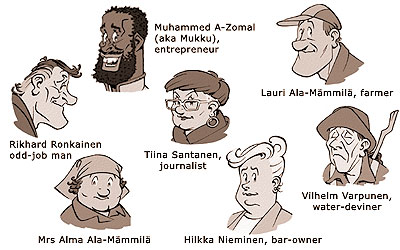

Contents 4/2002
Home


Extracts from the Mämmilä cartoon
©Tarmo Koivisto
Tarmo Koivisto’s ever-popular Mämmilä cartoon strip has offered a satirical reflection of the changing face of Finland over the past 25 years, Juhani Tolvanen writes
Beginnings are important. ‘The Jukola house,
in southern Häme, stands on the northern slope of a hill, near the
village of Toukola...’
‘In the beginning there were the bog,
the billhook and Jussi...’
‘The village of Mämmilä,
somewhere in central Finland, slumbers in its April idyll, no different
from dozens of others.... How do people exist and live here, what do they
do and get done?’
Just over a hundred years separate the beginnings
of these great Finnish narratives. The most popular Finnish novel of all
time, Aleksis Kivi’s Seitsemän veljestä (Seven Brothers),
was published in 1870, Väinö Linna’s massive national epic
about the transitional years of the 19th century, Täällä
Pohjantähden alla (Under the North Star) in 1959–62 and
Tarmo Koivisto’s Mämmilä – sarjakuvia Suomesta
(‘Cartoon strips about Finland’) in 1975.
Finnish society had never confronted a mirror
image that was as biting, accurate and funny as the Mämmilä
strip. The Osuuskunta Käyttökuva, a group of young graphic artists,
is behind the Mämmilâ series, but the plot lines are
the idea of the graphic artists Tarmo Koivisto (born 1948) and Hannu Virtanen
(born 1949).
The final writing and drawing of the strip, however, are the sole responsibility
of Tarmo Koivisto. Koivisto is also the author of other strips and newspaper
illustrations and has been active as a teacher and supporter of beginning
artists.
Mämmiläis, on a small scale,
a strip about a village community and that community’s development;
on the large scale, it depicts Finland and its development. The original
for Mämmilä (the name refers to the Finnish traditional
dish of mämmi, which is a frightening-looking, sticky, sweet
black malt porridge which not even all Finns will consent to eat) was
Tarmo Koivisto’s childhood home of Orivesi in central Finland, many
of whose buildings are recognisable in the strip. At first, the strip
appeared as a page every other week in a magazine, then monthly until
1996, when it began to be published in book form.
According to reader surveys, Mämmilä
was read in the 1990s by more than 15 per cent of Finns, and this figure
includes everyone from one- to one-hundred-and-one-year-olds! Few printed
works have attained such an achievement. Mämmilä is an
exceptional success story in the sense that the main character and hero
is a collective, in other words the village community, which lives a real
life: people are born, die, move, buildings are put up and torn down.
Life continues because it must be continued.
Tarmo Koivisto traces the lives of more
than 40 familiar people in such a way that death, which is ever-present,
has readers mourning characters who pass away. As a depiction of Finnish
agrarian society and municipal decision-making, Mämmilä
had a reputation as a reflector of reality from the very beginning; the
strip became a household name, rather like Kleenex or Walkman. All the
horse-trading that goes on behind decisions was dubbed Mämmilä.
In the history of Finnish cartoon strips,
Mämmilä also became a harbinger of change, as it made
cartoon strips an acceptable, if difficult, form of satire. As elsewhere,
in Finland the national cartoon strip tradition was at first comedy, then
comedy and adventure, and then, liberated by the American underground
tradition of the 1960s and 1970s, also experimental.
At first, Mämmilâ appeared
as one- to two-page episodes, of which a total of ten albums were published.
Those ten albums were gathered together into three collected volumes in
2000, awaiting this autumn’s new album. The strip ceased publication
in magazines in 1996 and Tarmo Koivisto began, with the support of a five-year
artist’s bursary, to prepare the album which became www.mammila.fi
(Otava, 2002).
The new album is a 74-page story about Mämmilä
and Finland in recent years. According to European Union statistics, Mämmilä
is the area’s most typical outlying habitation, which means that
it is to be made into an experimental information technology community.
It also tempts people into all kinds of activities, for better and worse,
which has also been the case in reality. Life, of course, goes on in Mämmilä,
although it is difficult to recognise it – or, indeed, Finland –
as the same place as in 1975.
The cartoon strip epic, which has grown
to almost 550 pages, covers the development of Finnish society over the
past 25 years from the advent of colour television to canine robots. If
you want to know how Finns’ lives, clothes or language have changed,
Mämmilä is an excellent reference work and guide.
Translated by Hildi Hawkins
![]()
Contents 4/2002 | Home